Menu
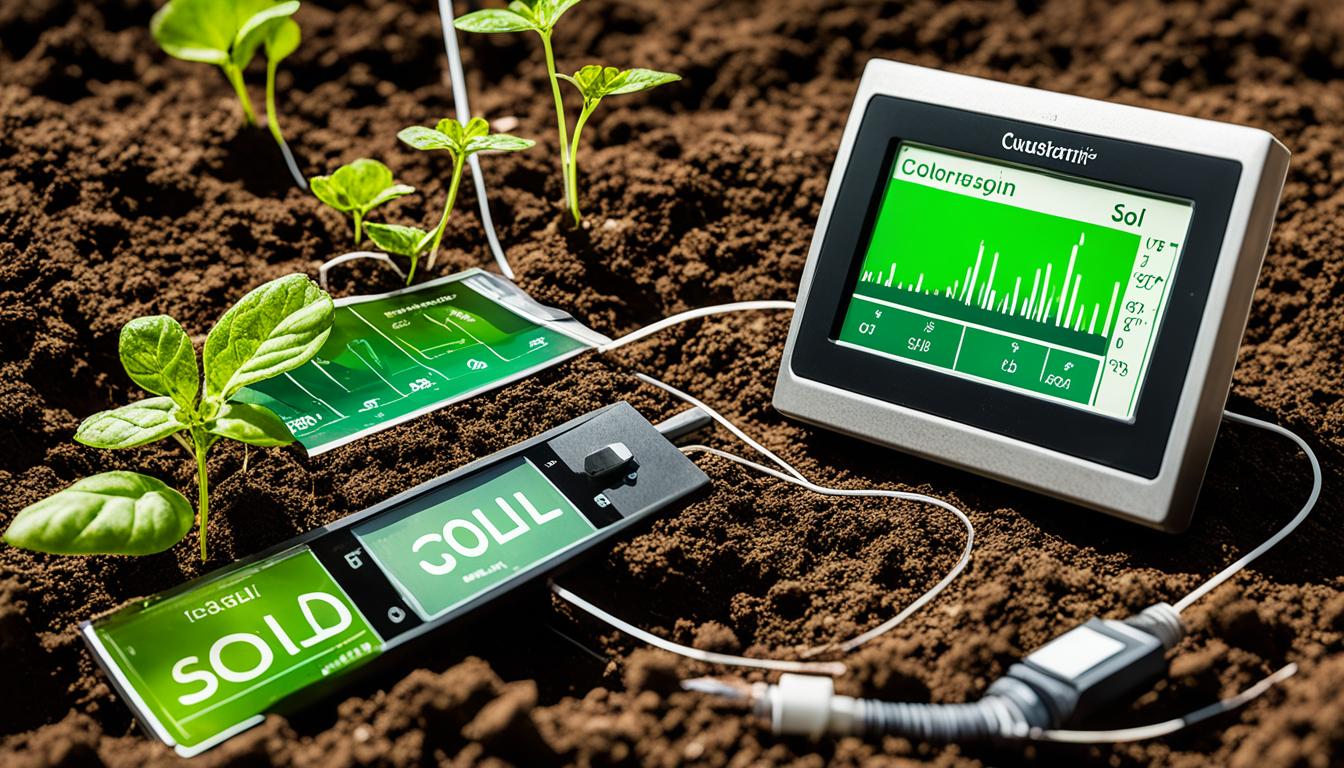
Did you know that 20-40% of the Earth’s land is losing its health? This calls for advanced solutions to protect our soils. At the University of Texas at Dallas, bioengineers have introduced electrochemical sensors. These sensors keep a close eye on soil aspects like carbon content, moisture, and pH. This innovative method provides farmers with precise, up-to-date data. It helps them manage their soil better, supporting sustainable farming.
Digital tools and scientific data are key in improving soil quality. The Syngenta Group’s Bin Buster project is leading in this field. Its goal is to analyse essential soil health factors and offer clear tips. With Syngenta’s Cropwise platform, Bin Buster sets an initial soil health measure. This information aids in choosing the right seeds, protecting crops, and increasing profits. It shows Syngenta’s push for better agriculture, focusing on sustainability and the use of advanced technology.
Healthy soil is essential for life, supporting both plants and animals. It’s made up of living beings, natural materials, and a good structure. The soil is key for our planet to stay balanced and is crucial for tackling climate change. The U.S. Department of Agriculture says soil helps keep our environment healthy and fights climate change by trapping carbon.
A healthy soil is rich in nutrients and organic matter. Sadly, half of all farm soils are in bad shape. This makes them more prone to sicknesses and bugs. Soil is also a big carbon saver, more so than all the world’s forests. This shows how important it is for fighting climate change.
Over 2 billion people worldwide lack key nutrients because of poor soil. Soil tests show it’s filled with toxins from industry, pesticides, and bad fertilisers. Using smart farming methods can clean up the soil and keep it healthy. This is crucial for our food and our planet’s future.
Good soil is great for farming and the environment. It acts like a sponge, soaking up water and stopping pollution from reaching our waters. Sadly, we’re losing soil fast, which could cost us a lot in the coming years. To keep the soil strong, we must use agriculture technology that doesn’t harm the earth.
Crops from healthy soil are better for us, with more nutrients and fewer health risks. Farm practices like changing what we grow, how we farm, and covering the soil can make it richer. This helps us grow more food and protects nature.
Experts agree that we must always check the soil’s health. This helps us see what works best to keep the soil fertile over time. Since soil traps more carbon than the air, keeping our soil healthy is key to fighting climate change.
In today’s world, new tech helps farmers more than ever. It’s crucial, especially with the increasing demand on water and feeding the world. Things like IoT soil sensors and AI are changing how farms manage soil.
At the heart of this change are IoT soil sensors. They keep an eye on important soil factors like moisture and nutrient levels. This real-time data lets farmers improve how they use water and grow crops.
Monitoring soil moisture closely is key. It can help use water better, very important with water predicted to be short in the future.
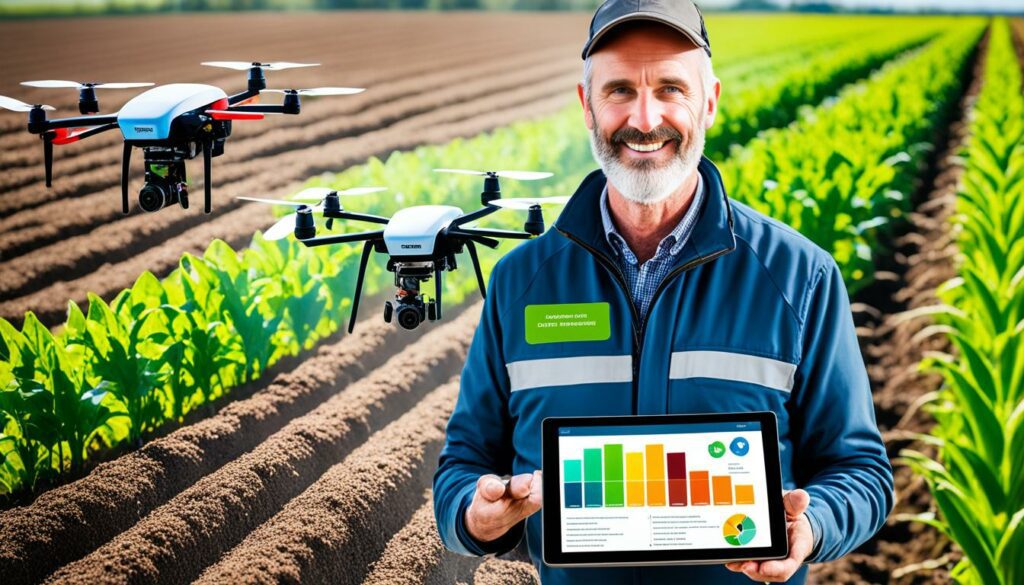
IoT sensors also help cut water waste in farming. They spot soil health problems early, keeping the soil good for growing crops.
AI and machine learning are also making big waves in farming. They can map soil and spot diseases early. This gives farmers high-tech tools to make farming more precise.
For example, AI can suggest when to spray pesticides. This can save resources and lower costs. Also, it can plan the best routes for farm work.
With AI, farming is becoming a lot smarter. It uses data to manage resources better and grow more food. This is super important as more food is needed for a growing world.
Digital tools like precision farming apps and soil analysis platforms have changed how farmers look after their soil. These tools use data to show farmers what their soil needs in real time. This helps make the soil healthier and grow better crops.
Precession farming apps give farmers detailed info on their soil. Created with tech from the University of Texas at Dallas, they track pH, moisture, and more. This data guides farmers so they can farm in ways that protect the soil and the environment.
Aside from collecting info, these apps work with other farming systems. They predict what will grow best in the soil and suggest improvements. This leads to more food, lower costs, and smarter farming.
Soil health is monitored better thanks to soil analysis platforms. These use special sensors made by UTD to check soil’s carbon and minerals. The info they provide is key for keeping the soil healthy and productive.
UTD and Soil in Formation (SIF) work together to push these technologies forward. Their partnership, funded by UT Dallas, lets farmers get very specific soil health insights. This could help solve big issues like not having enough food and climate change.
| Parameter | Measurement Capability |
|---|---|
| pH | Accurate |
| Moisture | Real-time |
| Soil Organic Matter | Continuous |
| Total Soil Carbon | Electrochemical Sensors |
In summary, using precision farming apps and soil analysis platforms is changing farming for the better. These tools offer a complete way of managing soil health. This helps farmers make their soil more productive and sustainable.
Ground-level sensors are key in managing soil health today. They are part of high-tech software used for looking after crops. These sensors keep an eye on important soil stuff like moisture, pH levels, and what nutrients are there. Farmers use this knowledge to water their fields, add fertilisers, and protect their crops.
A recent peek into 535 starting and growing businesses showed what’s up with soil health in 2023. The StartUs Insights Discovery Platform found trends by looking at millions of these businesses worldwide. The report gives a good overview of the soil health scene.
What’s cool about these sensors is they do a lot with the data they collect. They help farmers make the best use of their land by providing up-to-the-minute soil info. This kind of farming is good for the planet. For example, sensors can tell the farmer when to water based on soil moisture, saving water and growing better crops.
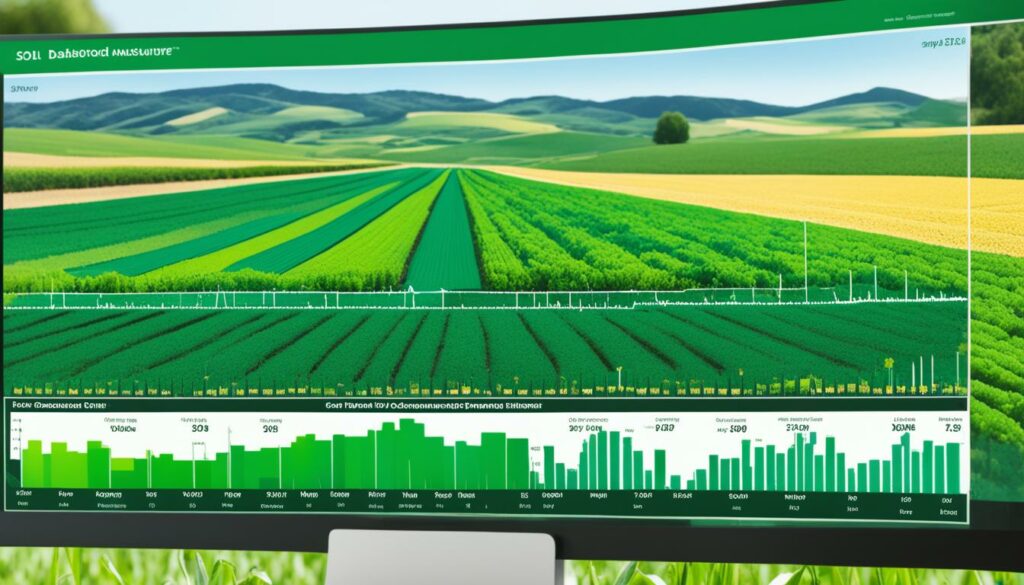
Soil temperature is really important for plant roots and how they use nitrogen. Soil moisture matters too, for plants and for filling up the water underground. When crop software and smart systems work together, they can automatically water the fields just when they need it. This saves water and makes crops healthier.
Take for instance the Farmsys Soil Spectra. It keeps an eye on the soil and the weather. N-Sense is another neat tool. It uses fancy tech to figure out exactly how much nitrogen plants need. And there are companies like SoilSerdem and Map My Crop. They use high-tech soil sampling and maps to show where crops will do best.
These ground-level sensors are a big deal for farming that cares about the earth. They give loads of soil info, which helps make crop software better. This can increase how much farmers grow and lower the harm to our environment.
| Startup/Scaleup | Innovation | Application |
|---|---|---|
| Farmsys | Soil Spectra | IoT soil monitoring and weather tracking |
| N-Sense | Fourier-transform infrared spectroscopy | Precise nitrogen fertilizer application |
| SoilSerdem | Optimised soil sampling | Creating fertility maps |
| Map My Crop | GIS-based mapping | Detailed soil productivity maps |
In the last few years, using new technologies has made soil mapping much better. This has really helped with managing land and making more food from it. These changes are key for dealing with issues like soil health, how much food we grow, and protecting the environment.
AI in farming has brought big changes, making soil studies very accurate. EarthOptics is a leader in smart soil work, covering a million acres. Thanks to AI, we can spot diseases in the soil early and protect our crops. AI also looks at loads of data to draw very detailed soil maps. These maps are vital for better farming and making the soil more productive.
Using satellites and drones is changing how we keep an eye on the soil. More than 85,000 areas worldwide are using these high-tech methods. Thanks to satellite maps, we can see our grasslands in new ways. This helps us manage them better and do things like lock away 10% of the world’s yearly greenhouse gases. It’s a big step towards farming more sustainably.
| Technique | Application | Impact |
|---|---|---|
| AI-Powered Soil Mapping | Early disease detection, high-resolution soil maps | Enhanced soil productivity, sustainable land management |
| Remote Sensing | Satellite-derived maps, UAV technology | Comprehensive rangeland views, improved data for decision-making |
Aerial imaging technologies, including drones with high-tech cameras, are changing how we monitor soil. They capture detailed images of the ground from above. This helps in precise farming, improving how we use and manage soil.
Drones can cut planting costs by up to 85%. This is a big advantage for modern farming. They allow farmers to see plant problems early. This means they can act fast, reducing how much of their crop fails.
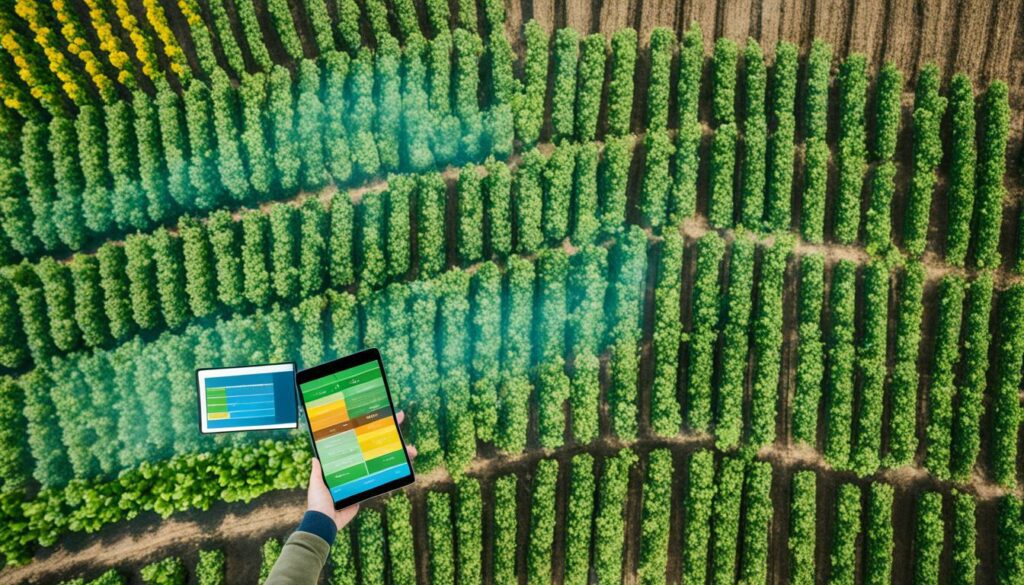
Using drones, farmers can make maps that show soil and plant health. These include RGB and NDVI maps. By looking at these maps, farmers can learn a lot. They find out about soil moisture, crop health, and much more. Companies like HANA Resources use this technology for detailed site checks, aerial maps, and even spotting algae.
Drones also help watch over animals and guess how much crop will grow. They check things like the size and density of plants. This helps predict how much crop there will be. It also guides farmers in where and how much to plant. Drones with special sensors can even work in rough, changing landscapes to get accurate readings.
In short, drone imaging is a key part of modern farming. It gives farmers very detailed ways to check on plants and soil. This leads to saving time and reducing the need for lots of people to work on the farm. This way, farming is getting smarter, faster, and more efficient.
| Feature | Benefit |
|---|---|
| Planting Costs Reduction | Up to 85% decrease |
| Early Detection | Bacterial and fungal infections |
| Yield Estimation | More accurate predictions |
| Mapping | RGB and NDVI maps |
| Crop Monitoring | Real-time inspections and data |
| Livestock Monitoring | Counting and movement patterns |
Robotics are making big changes in how we look after soil. Smart farming tools and robotic farming assistants help with accurate soil sampling and quick analysis. This leads to better choices for farming and a green future.
Soil sampling robots are a big deal now. The Small Robot Company’s robots have started a new era in checking soil health. They can find out lots of details about the soil, like how much life is in it and what it’s made of, quickly and exactly.
These robots don’t just take samples. They learn about the soil using smart tech. They even test the air above the soil to get even better information. This step makes things faster and cheaper than the old way.
Robotic helpers don’t just draw soil samples but understand the data too. Thanks to PES Technologies, these bots can smell different things in the soil. They use the latest AI and learning tech to give farmers better advice.
Thanks to robots, we can measure how much carbon is in the soil easily. This is key for UK farming to be carbon neutral by 2040. The aim is to turn 18 million tonnes of emissions into 6 million tonnes of CO₂ captured every year. With robots taking billions of precise measurements, farms can sequester carbon very well.
| Robotic Technology | Function | Impact |
|---|---|---|
| TerraSentia | Soil data collection & analysis in real-time | Efficient soil monitoring; reduces traditional sampling labour and costs |
| AgBot II | Autonomous soil data collection | Improves soil health insights; optimizes farm operations |
| RoboTiller | Tillage, fertilization, irrigation, and weed control | Enhances soil structure; reduces erosion and emissions |
Using robots in farming is helping a lot. It’s making soil care and farming better while protecting the planet. This technology is key for a sustainable future in farming.
In today’s farming, using advanced techniques to check soil has changed everything. The Bin Buster project, run by Syngenta Group, is a great example. It checks soil on hundreds of acres in the middle of the US. The tests look at soil texture, how compact it is, how much water it can hold, breathes, and its pH. With the help of high-tech software, farmers can choose the best fertilisers. This leads to healthier soil.
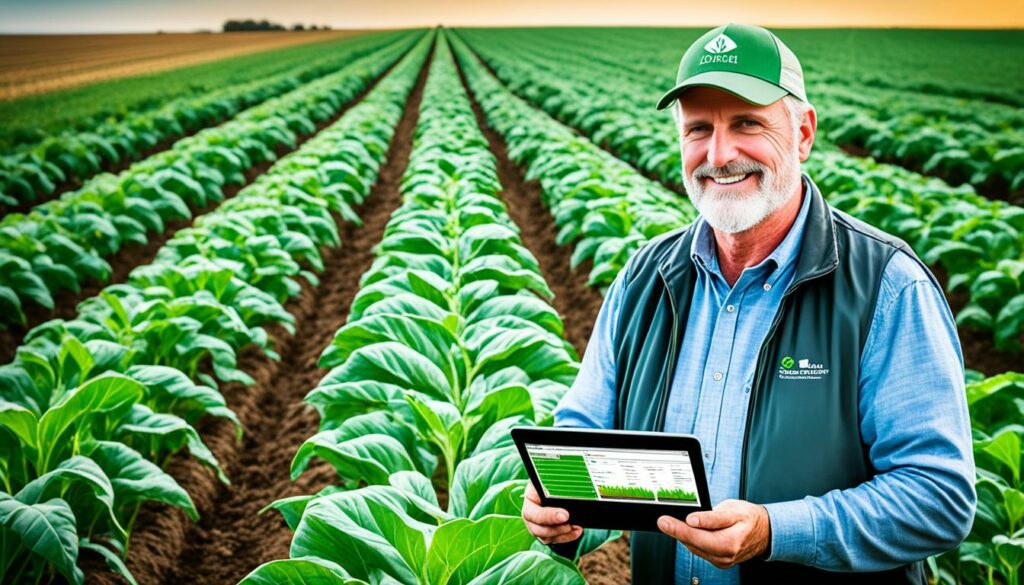
The Bin Buster project started in 2019 with a focus on the best use of nitrogen and fungicides for corn. Thanks to Syngenta’s Seed Selector, corn seeds chosen with this tool do a lot better. They are up to six bushels per acre better than seeds chosen at random. Also, farmers follow the USDA’s advice on soil health. They keep the soil covered, touch it less, plant all year, and use different plants.
To gather data, the project uses special sensors, cameras, and even soil-moisture probes. Soil samples go through detailed tests at places like Cornell University. The tests look at if there are enough good microbes and fungi in the soil. They also check signs of nutrients like nitrates. All this information helps farmers make smart choices with their software.
Syngenta uses its products like Golden Harvest seed, Acuron herbicide, and others in this work. They also look at how good these methods are for our planet. They think about things like less greenhouse gases, saving energy, and keeping the soil’s carbon. Such modern methods help in looking back to 2015 at the soil’s health. This shows where soil needs care most.
The project’s big win is finding places where the soil can improve a lot. Healthy soil from Bin Buster grows plants that are tough against diseases and lack of water. Also, the team checks a small part of the ground from 0.5% to 5%. This is to make sure they always know where to make their soil even better.
Nanotechnology is changing the game in how we manage soil health. It focuses on fixing nutrient issues precisely. This boost helps make farming more sustainable.
Using nanotech in farming can clean contaminated soil by taking out heavy metals. Surprising results show that coated FeO NMs remove 100% of Pb in 24 hours and Cd in 48 hours. Also, bio-sorbents with dried Staphylococcus aureus and n-Fe3O4-Phth-S complex can get rid of Cu, Ni, and Pb well.
Heavy metal-resistant bacteria with ZnO NMs can remove metals like Cr, Cu, and Pb effectively. Tests with OA-nZVI NMs have taken away a good amount of Cd, Pb, and Zn from polluted soil.
Nanotechnology also boosts soil enzyme activities and plant growth. It can increase dehydrogenase activity by 32.8%, catalase by 566.7%, and boost crop yield by 150.64%. This improves soil health, making it more fertile for crops.
Nano-fertilisers improve soil around plant roots, known as the rhizospheric region. They impact the ecosystem of soil bacteria. Although some areas might see less enzyme activity at first, the long-term gains in soil and plant health show nanotech’s promise in farming.
So, using nanotechnology in soil management could make farming better at dealing with climate change. By adjusting the soil’s tiny world with nanotech, we could improve soil health and grow more crops. This shows a lot of potential for the future of farming.
At the top of the tech game stands blockchain. It’s ready to revolutionise farming by making soil data safe and clear. With blockchain in agriculture, the system’s not controlled by one person. This means you can trust the ground’s health stats and other key figures from the farm.
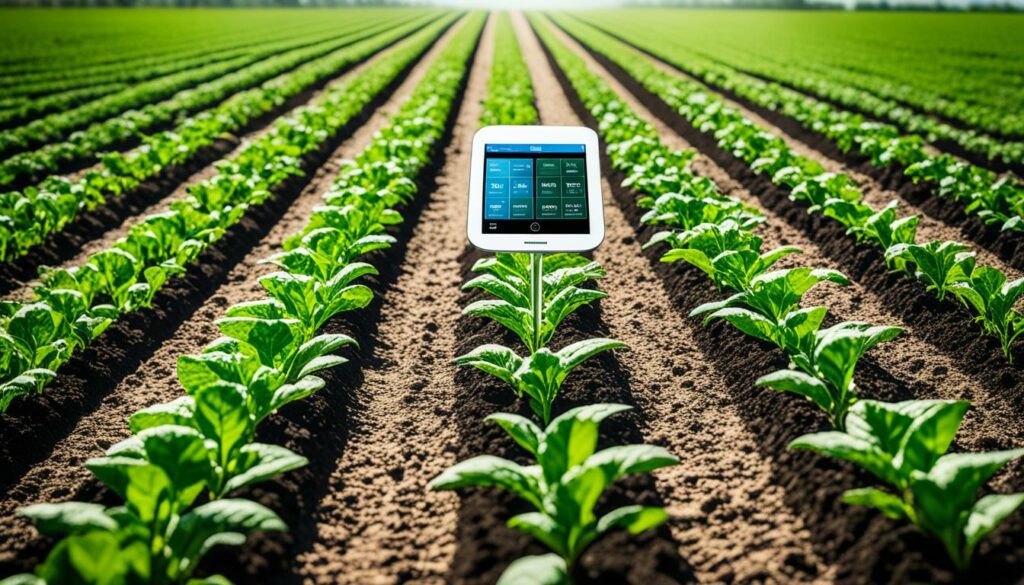
The Soil Monitoring Innovation Map is buzzing with news on the top 10 soil monitoring trends. These trends reach 535 companies all over. Blockchain tech really shines here. It’s great at making sure data is safe and where it came from. This helps everyone in farming feel more sure and work together better.
Think about new tech like soil sensors and soil maps from above. They’re changing how we look after the soil. Blockchain is a key partner here. It keeps a record that can’t be changed. So, things like data from soil sensors stay safe and true. Companies like Farmsys use IoT soil sensors, like Soil Spectra. They watch over soil in important ways. By using blockchain, the sensor data can be kept safe and shared across farms.
In the US, a startup called Map My Crop uses satellites to make soil maps that show how good the soil is for growing crops. By bringing blockchain in agriculture into this, the maps become even more reliable. Blockchain makes sure that old farming data stays true and clear. Another company, N-Sense, checks levels of soil nitrates with a special machine. Blockchain tech makes this process secure and exact.
In Botswana, Anton Tech focuses on tracking soil carbon using drones and smart computers. Adding blockchain helps share this vital data with the right people without worry. Also in the US, S-A-M Technologies and Vertum Technologies are doing great work. They’re using robots to keep tabs on the soil and help with farming. Blockchain steps in to make sure the data from these robots is straight up and helpful.
| Startup | Technology | Blockchain Integration Benefit |
|---|---|---|
| Farmsys | Soil Spectra IoT Sensor | Secure data storage and sharing |
| N-Sense | Soil Nitrate Monitoring | Verified spectral signal data |
| Map My Crop | Soil Productivity Maps | Secure historical yield data |
| Anton Tech | Drone-Based Soil Carbon Monitoring | Accurate carbon data reporting |
| S-A-M Technologies | Automated Soil Monitoring Robots | Reliable condition data |
| Vertum Technologies | Robotic Farming Assistants | Data integrity for soil health analysis |
Using blockchain in agriculture opens a door to trust and clear data in soil management. It teams up with new soil tech to change farming for the better. This could mean smarter, greener farming that’s good for everyone, from farmers to people who eat the crops.
Keeping the right moisture in the soil is key for farming that cares for the environment. Today, farmers use digital tools to help. With smart irrigation and sensors that check soil wetness, they make sure their crops have just enough water. This way, they grow more and use water better.
Smart irrigation is a top way for farmers to control soil moisture. Using sensors and data, these systems water crops when they need it most. Syngenta’s smart farming system gives farmers advice about their soil. It helps them grow more while saving water, which is very important nowadays.
Hydration sensors are like eyes for the ground, helping farmers know if it’s too dry or too wet. They come in different types but all work to make sure crops get just the right amount of water. This is important to keep plants healthy and for saving water.
| Type of Device | Function | Benefits |
|---|---|---|
| Smart Irrigation Systems | Automated and real-time water application | Enhanced water use efficiency, improved crop yield |
| Hydration Monitoring Sensors | Continuous soil moisture monitoring | Prevention of drought stress and waterlogging, optimal resource application |
| Soil Moisture Probes | Measurement and data transmission of soil moisture | Efficient water management, soil protection |
Using digital tools to look after soil moisture, projects like Bin Buster show how farming is getting better. With things like Syngenta’s Seed Selector, soil and crops are healthier, and the Earth is happier too. Regularly checking and changing how they water, farmers are moving to smarter and greener ways of farming.
Digital tools are key for sustainable farming. They help track soil health and reduce the impact on nature. For example, Syngenta’s Bin Buster uses top tech to check soil on big farms. This started in 2019 and focuses on how much nitrogen and fungicide corn needs. It has boosted crops a lot.
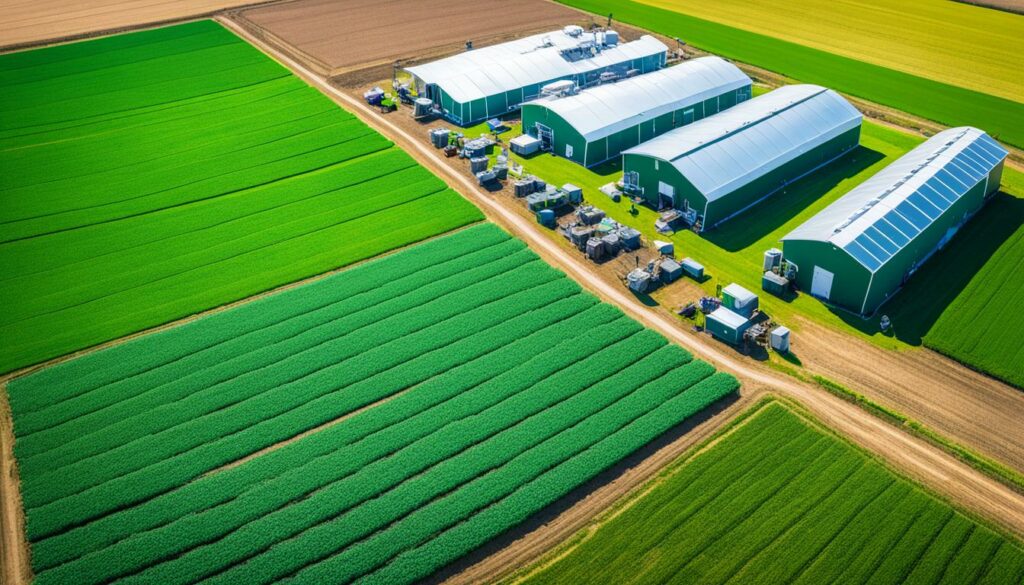
Syngenta’s Seed Selector is impressive. It found the right seeds, increasing corn yield by six bushels an acre. This highlights how important new tech is for farming.
At Syngenta, they use sensors, moisture probes, and super detailed pictures to check soil. This helps the Cornell University Soil Health Lab manage soil better.
They also look closely at energy use and how much carbon the soil has. Syngenta uses high-tech software to track all this farming info.
The aim is to have plants that bounce back easily and give great harvests. Plus, use water better to help nature. Combining AI, IoT, and blockchain saves resources and makes farming less harsh on the planet.
The future of farming is all about digital growth. This new kind of farming, or Agriculture 4.0, uses big data and smart tools. It started with detailed soil maps and now includes IoT. Soon, Agriculture 5.0 will bring in robots for even better efficiency.
Adding digital technology to soil health checks changes the game in farming. Farmers can now get real-time data and predictions. This helps keep their land productive for the long haul. Else K. Bünemann and Giulia Bongiorno’s work has shown how checking soil has evolved. And, it’s crucial to include everyone involved in the process.
Setting clear goals for soil checks and picking the right indicators is key. It’s important to understand soil quality clues and use tools that fit everyone’s knowledge. This shows the need for precise technology in farming. Researchers highlight how digital tools improve taking care of soil.
Next, new tech like IoT soil moisture sensors and metagenomics looks very promising. They aim to make soil health checks more advanced and better. Real examples show us the huge cost of bad soil and climate problems. The need for smarter farming to fight climate change is urgent. This message comes from top sources in the field.
Digital tools in checking soil go beyond measuring. They are key in making farming greener, more efficient, and strong. By working together, farmers, businesses, and scientists can use these new tools. They help us care for the environment and make sure we can farm well in the future.
Soil health digital tools help monitor and improve soil conditions. They include software and apps for soil quality and farming. These tools give real-time data to boost soil health and productivity.
The soil ecosystem is key for plant and animal life. It helps with carbon storage and climate balance. This leads to strong crops, saves water, and boosts yields.
IoT soil sensors check moisture, pH, and nutrients. They give data for better farming decisions. This improves farming’s impact on the environment.
AI helps find early diseases and make smart maps. This tech supports better farming choices, improving both the land and crop outputs.
These apps spot soil differences and suggest actions. They help farmers use resources better. This means healthier soil and crops.
These platforms test soil and give insights. They use high-tech methods to help with soil treatment and fertilisation choices.
Sensors watch soil, giving info on moisture and more. This helps farmers make better choices for their land, staying eco-friendly.
AI and remote sensing find diseases early and suggest land tasks. This boosts soil use and keeps it healthy for years.
Drones take detailed soil pictures for better farming. This method oversees large areas, leading to advanced land care and bigger harvests.
Robots take precise soil samples for better analysis. They help with condition checks and improve water use, making farming more exact.
Methods like microbial analysis are key for treating soil well. They guide actions, ensuring the land is at its best.
Nanotech delivers nutrients effectively, improving soil use. It’s a step towards smarter, environmentally friendly farming.
Blockchain secures soil info, helping in tracking its health and tools. It increases trust, aiding in better land care.
Smart tools ensure water is used well, keeping the soil moist without waste. This supports eco-friendly farming.
Digital tools manage farming resources well, cutting harm to the environment. They promote water saving and enhance soil health for a better, sustainable farm future.